Self-study lesson plans and training record download page.
What hydraulic radial pumps are used for
Radial hydraulic pumps are used when pressure requirements exceed those of axial piston pumps. Radial pumps are capable of achieving pressures over 400 and up to 1000 bar. This makes them ideal for applications such as machine tools, test rigs, presses or clamping applications that require higher loads.
Radial piston pumps generally have fairly low flows but also low noise. They have good low-speed operation and reliability along with high efficiency.
How hydraulic radial pumps work

Radial piston pumps work by having an eccentric shaft that pushes radially positioned pistons outward to provide flow, then when they are drawn backward, a valve inside the piston opens to allow new fluid into the piston and stop the pressurised fluid from returning into the piston cavity. Designs are balanced with few side loads.
Different types of radial pumps
Although the general approach remains similar, individual manufacturers have different designs within their piston mechanism.
Tips for operating and maintaining
Slow speed motors are sensitive to temperature and axial loads
Typical operating characteristic
TBC
How to specify
TBC
Design Tips, techniques, and potential issues
TBC